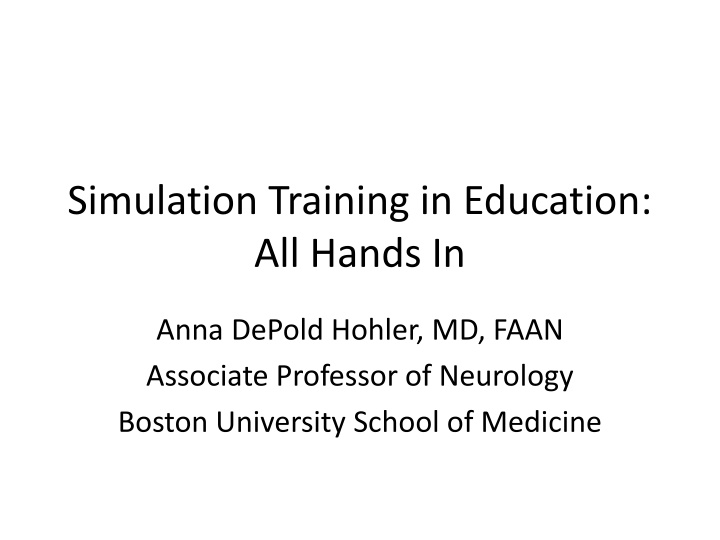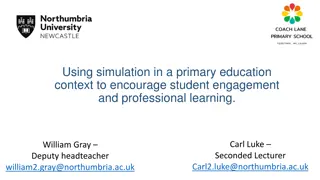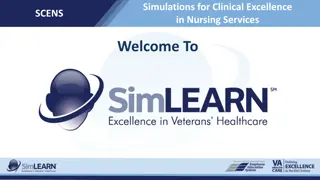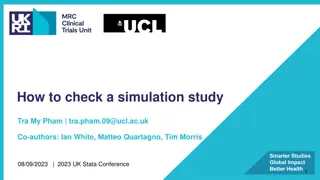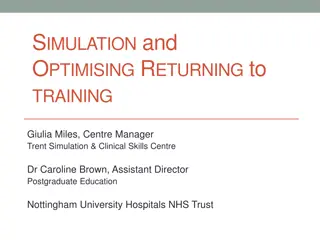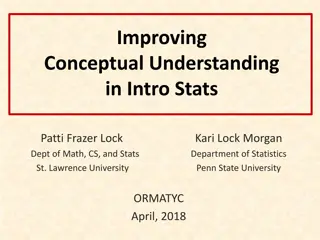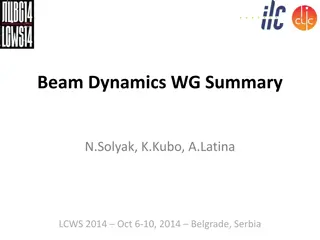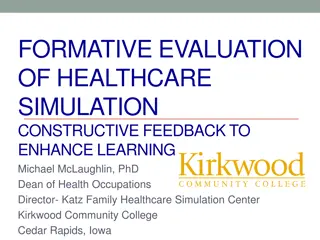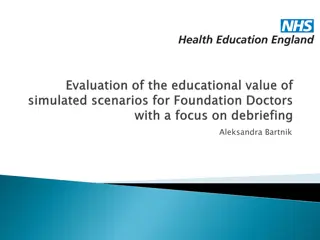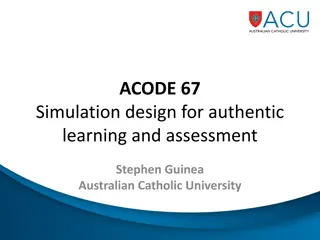Simulation Training in Education: Enhancing Learning Through Hands-On Simulation
Hands-on simulation training in education provides students with valuable learning experiences by increasing self-reported knowledge and technical proficiency. Simulations help improve students' knowledge, experience, and comfort with challenging procedures in a lower-risk environment, leading to enhanced outcomes across various learning areas. Criteria for successful simulation learning involve creating realistic, hands-on scenarios tailored to students' developmental levels and encouraging active student participation. Examples such as the lumbar puncture simulator demonstrate how simulations can effectively replace traditional teaching methods, offering a safer and more effective way for students to develop necessary skills.
Uploaded on Sep 11, 2024 | 2 Views
Download Presentation

Please find below an Image/Link to download the presentation.
The content on the website is provided AS IS for your information and personal use only. It may not be sold, licensed, or shared on other websites without obtaining consent from the author.If you encounter any issues during the download, it is possible that the publisher has removed the file from their server.
You are allowed to download the files provided on this website for personal or commercial use, subject to the condition that they are used lawfully. All files are the property of their respective owners.
The content on the website is provided AS IS for your information and personal use only. It may not be sold, licensed, or shared on other websites without obtaining consent from the author.
E N D
Presentation Transcript
Simulation Training in Education: All Hands In Anna DePold Hohler, MD, FAAN Associate Professor of Neurology Boston University School of Medicine
Simulation in Education Hands on skills training with simulators provides a valuable learning experience for students. Simulation use results in an increase in self reported knowledge and technical proficiency. Knowledge, experience, and comfort with dangerous and technically challenging procedures are improved.
Simulation in Education Simulation can result in improved outcomes and products in all areas of learning. Simulation has widespread applicability throughout science and medicine. Designing learning experiences that closely mimic the live experience allows students to acquire skills in a lower risk environment.
Simulation in Education Simulation education can also be repeated, standardized, and troubleshooting can be incorporated. While simulation can never fully replicate the in vivo experience, it serves to make the live performance less anxiety provoking for the student.
Simulation in Education Criteria for Learning The simulated activity shows little difference between the simulated environment and the real one. They are "hands-on", involving students so they become participants. They are tailored to the student. Student input is welcome. Simulations take into account the students' developmental level. Students develop problem solving tools as a result of the interaction.
Simulation in Education Examples The lumbar puncture simulator: Proficiency with the lumbar puncture has traditionally been attained with a bedside tutorials. The lumbar puncture can be uncomfortable, technically challenging, and is most often performed in serious circumstances involving elevated brain pressure, infection, or bleeding. Side effects range from a mild headache to rare but life threatening brain herniation. It is one of the most difficult procedures that is performed at the bedside and requires skill and experience for success.
Simulation in Education Examples At BUSM prior to 2011 students received classroom teaching and had the opportunity to observe lumbar punctures on the wards and in the lumbar puncture clinic. In 2011 we purchased two lumbar puncture simulators to use in training sessions. Students went through a pre-procedure checklist including informed consent, positioning of the patient, lumbar puncture kit set up, procedure sterile field preparation, anesthetic administration, needle insertion, opening pressure monitoring, fluid collection, and CSF analysis. Students had the opportunity to experience different lumbar puncture positions and complexity. This served as a troubleshooting challenge.
Simulation in Education Examples We surveyed 155 third and fourth-year medical students who used the lumbar puncture simulator, the percentage of students feeling comfortable in all assessed aspects regarding the LP improved from 11 percent of students to 87.7 percent after use of the simulator. We have started to disseminate this information to neurology clerkship programs across the nation and have also started to standardize this training technique to our neurology residents. Our plan is to disseminate this simulation teaching to other departments like medicine and emergency medicine.
Simulation in Education Examples Stock Market Simulator: http://www.smg2000.org/ The Stock Market Game program has given educators a way to improve the learning experience in thousands of classrooms. The Stock Market Game program enlivens core academic subjects including Math, Social Studies, and Language Arts. The Stock Market Game program offers a vast library of learning materials correlated to national voluntary and state educational standards in Math, Business Education, Economics, English/Language Arts, Technology, Social Studies and Family and Consumer Sciences. This resource has inspired many teachers to incorporate the program into classes in creative ways at all levels, from fourth grade to college, all across the curriculum.
Simulation in Education Example Math, Physics and Engineering Simulations http://www.falstad.com/mathphysics.html
Simulation in Education It is feasible that simulated laboratory skills training, scientific experiments, and even simulated animal models may enable the development of improved technical proficiency, improved exposure to scenarios, and the conservation of valuable resources.
Additional Bibliography Education Simulation: http://www.creativeteachingsite.com/edusims.html Ross J. Scalese, Vivian T. Obeso, S. Barry Issenberg. Simulation Technology for Skills Training and Competency Assessment in Medical EducationJournal of General Internal Medicine, January 2008, Volume 23, Issue 1 Supplement, pp 46-49.
